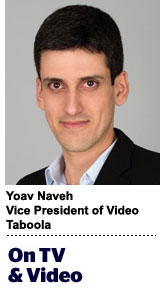 “On TV And Video” is a column exploring opportunities and challenges in advanced TV and video.
“On TV And Video” is a column exploring opportunities and challenges in advanced TV and video.
Today’s column is written by Yoav Naveh, vice president of video at Taboola.
Brands love cookies, digital marketers love cookies and marketing executives around the world still love them for their ability to target the right audience.
Our industry has built a lot of technology around cookies. We know how to find and target the right users to capture their attention, but it wasn’t always so simple.
Some technology companies took advantage of marketers’ devotion to audience targeting and did things like serving ridiculously small video ads that would never be seen. Advertisers were then charged a premium as if it were a television placement, just because it was served to their target audience.
When brands realized this, they rightfully added a new viewability metric. Unfortunately, the emphasis on viewability came with a cost.
There are many ways to make a video viewable. You can put it higher on the page so it’s viewable, or you can play it in a small banner that’s sticky so it’s viewable. You can also place it next to text so that while people read the content, the video is playing in the background.
But do users watch the video? No. Videos may be shown to the right audience and are 100% viewable, but no one engages with them.
When we started with a cookie, brands asked for viewability, but what they really want is consumer engagement.
Engagement Levels Differ
Each ad campaign has a different goal. Some strive for brand life, some strive for conversion and some strive to send users to more content.
Depending on the goal, the number of users that engaged is what’s important, not the number of potential viewers.
Consider two scenarios when videos can be 100% viewable: YouTube (pre-roll) and games (in-app, incentivized views). YouTube is probably the closest to mass market TV ads, while in-app incentivized views are killer for app installs and CPA optimization. Both can be 100% viewed, but engagement is very different.
No matter the ad format chosen, merely getting ads in front of the user shouldn’t be the focus. Once an ad is served, assuming it is in front of the right audience and viewable, optimizing for engagement is what will really move the needle.
By focusing on viewability, we’re driving the wrong behavior. Instead of a video ad that is presented to achieve the brand’s goal, whatever it is, we get one in-banner ad, then a second and a third – sometimes one after another, and sometimes all three at once.
Viewability will evolve much like audience targeting did. Unless we focus on what we’re trying to achieve and measure it at scale, we’ll constantly drive the wrong behavior.
I’m not recommending that marketers replace viewability with engagement. You can’t engage with something you can’t view.
I’m suggesting that marketers start classifying different forms of advertising for their specific needs. Not all views are created equal, and engagement demands quality views, not quantity.
The Bottom Is Better Than The Top
When users open a web page, they’re in a different state of mind than when they’ve finished consuming their desired content or have watched a video.
When they’re initially engaging with the page, they’re ready to consume, and this could make the top of the fold a great place for a brand awareness campaign, but marketers will have their attention for only a few seconds. When users have finished reading or viewing, they’re ready to make decisions, which could make the bottom of the page a good place for conversion or engaging with even longer content. Decisions are made at the bottom of the page.
Video: The Future Of The Open Web
Optimizing ad units was the next natural step for marketers after they demanded viewability. But we need to know the optimal unit before brands start their campaigns, and for that, the industry needs to grow.
In the past, there was a scarcity of premium video outside of social media and YouTube. Now, I believe this is going to change on a global scale. As we discover more about user behavior on the open web, brands will begin to discover safe and scalable environments to reach their audiences across the internet.
The next step in the evolution of digital advertising isn’t to chastise brands for measuring viewability. Our past mistakes have caused a hype that made cookies our end-all and be-all. Instead of demanding more views, let’s think about the user, their experience and the impact of brands.
Follow Taboola (@taboola) and AdExchanger (@adexchanger) on Twitter.
This post was syndicated from Ad Exchanger.

More Stories
ThinkTV campaign tackles The TV Advertising Paradox head-on
EXCLUSIVE: Most Americans Don’t Care If TikTok Shuts Down
Trump Grants TikTok a Second 75-Day Extension, Pushing Deadline to Mid-June